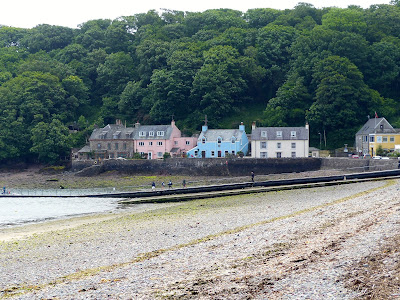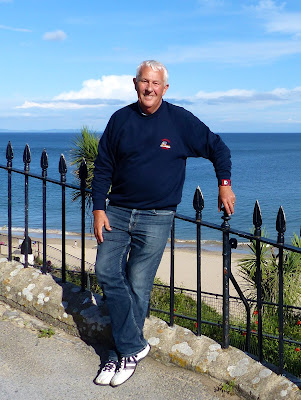DAY 26
Friday 17th
2016
Cardigan to
Tenby Miles 106
Today I have driven through almost zero visibility in cloud and
rain and also perfect visibility in beautiful sunshine. I have visited yet another castle and been
joined by a friend for the next part of my journey.
Leaving Cardigan early this morning I set off for Fishguard,
another ferry town with ferries across to Ireland. Unfortunately as I crossed the border into
Pembrokeshire, everything became grey and overcast with drizzly rain. I got
some clearance so that I could see the small town of Fishguard. The beach close to the ferry dock seems to
have grey uninviting sand rather than the golden coloured sand that I was to
see along the cost later in the day.. As
I set out to get to Strumble Head the rain intensified and the cloud cover
increased. The road on which I was
driving was at a low level in relation to the fields and there were high
hedges. This was the predominant feature
of most of the roads today. So, unless
the road actually ran along the edge of the beach, views were limited to grass
banks and hedgerows. Even though I have
to drive these roads to keep true to my objective of driving whatever road is
closest to the ocean, there was little sign of the ocean and I could have been
driving anywhere. No doubt you have to
be sitting on a double decker bus to get a good view!
I had never been to Pembrokeshire before so I was very much
looking forward to it and viewing the much talked about coastline. Unfortunately the weather and the hedgerows
did not play ball and I was limited in what I saw until later in the day.
Another one of my objectives was to visit the city of St. Davids
and its cathedral. Until very recently to be a city in the UK the town had to
have a cathedral. A favourite pub quiz
question has often been ‘What is the smallest City in the United Kingdom’. The answer was St. Davids, which had a
cathedral, though the town itself was very small. Quite recently the ‘need to have a cathedral
to be a city’ rule has changed and there are places now designated as Cities
that do not have a cathedral.
 |
| The Nave |
St Davids is a lovely cathedral.
Alongside it is the ruins of the Bishop’s Palace, which appears to have
been almost as large as the cathedral itself.
 |
| St David's Shrine |
St. David lived from 500 to 589.
He was born into royalty with his father being Prince of Powys and his
mother the daughter of a local chief. In
medieval times they believed that he was the nephew of King Arthur. He became a monk and insisted that no
personal property could be owned. It was
also said that he founded Glastonbury Cathedral and, though this cannot be
proved, there is evidence that he was responsible for plans to expand
Glastonbury. He was canonised as saint
in 1120. He was buried in what is now
the cathedral but in the 12th century it was sacked and burnt by the
Vikings. Bones said to be those of St.
David were carbon dated in 1996 but turned out to be bones from the 16th
century.
The cathedral has some fascinating wooden bosses on its
ceilings. It is not as elaborate as many other cathedrals, but is still a
magnificent building. It was a place of
pilgrimage for many years and on every Friday at noon there is a short service
to remember St. David.
Traveling through Wales the Welsh language is very much in
evidence. The road signs are in Welsh
(first) and then in English. In
Caernarfon I heard many people in the streets and shops talking in Welsh. Wales
is very much a land of two halves. The
people of the north speak Welsh and use it in every day conversation, whereas
the people in the south of Wales, speak almost entirely in English. Until today I had not appreciated how much
this was like Scotland where the highlanders of the north keep their gaelic
language alive, but the lowlanders of the south stick mainly to English. In Scotland the highlanders have a Nordic ancestry
whereas the lowlanders have more of an Irish origin. In Wales the south became industrial and interacted with the English, plus the immigrants who came to work in the mines. However the more rural north was less affected by outside contact so the language remained in daily use. Since the formation of the Welsh Assembly, every child at school in Wales is now learning Welsh. Considering I was in Scotland only 5 days ago, this really highlights
just how varied the British Isles are, two completely different languages only
a few hundred miles apart.
After visiting the cathedral I then drove along St Brides Bay.
This took me right alongside the water.
There were wind surfers braving the elements, but not many other people
on the beach. Again I lost sight of the
water as I drove through the lanes emerging again at the small village of Dale
where the sun at last began to break through.
Dale is another one of those places where rather drab looking buildings
have been painted in bright blues, yellows, pinks and whites and the colours
seem to harmonise so well with the colours of the landscape.
I next had to travel back through the lanes, again out of sight
of the ocean, heading towards Milford Haven.
Milford Haven is an industrial port mainly serving the oil and gas
industry and my first sight of it was across of field of cows. The sight of the towers and chimneys seemed
in sharp contrast to the rurality of the field of cows from over which I first
espied the chimneys.
 |
| Towards Milford Haven |
 |
| Pembroke, viewed from the castle |
 |
| Pembroke Castle |
My destination for today was Tenby, where I was to meet my
friend Bob at the railway station. I
arrived about 1 minute before his train and it was good to meet up with him
again and to share his company. Together
we drive into Tenby to look for some afternoon tea.
Tenby revealed itself to be one of the most beautiful places
that I have come across so far on my trip around Britain. It was a wonderful sight looking down onto
the boats bobbing around in the natural harbor and the water sparkling in the
sunlight.
I later discovered that there
are at least four separate beaches in Tenby all with great sand and great
views. This is a town that I would certainly like to return to and perhaps stay
a while. My sister had told me how
lovely Tenby is and she was not wrong.
 |
| Tenby Harbour |
Bob and I were assisted by the Tourist Information Office in
finding a lovely place to stay in Lamphey. This meant a journey of about 7
miles back towards Pembroke, but the small hotel proved to be extremely
comfortable and their dining room excellent (but their internet connection was
non existent, hence this edition of the blog is late).
Tomorrow we have a long drive through South Wales and back into
England and Bob will leave me at Bristol.
I will then be on my own again on Saturday evening in north Somerset and
north Devon before being joined by another friend Pete, in Bude on Sunday
night.







No comments:
Post a Comment